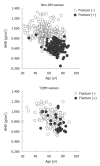Bone fragility in type 2 diabetes mellitus
- PMID: 22474621
- PMCID: PMC3302026
- DOI: 10.5312/wjo.v1.i1.3
Bone fragility in type 2 diabetes mellitus
Abstract
The number of patients with osteoporosis or type 2 diabetes mellitus (T2DM) is increasing in aging and westernized societies. Both disorders predispose elderly people to disabling conditions by causing fractures and vascular complications, respectively. Recent animal studies have shown that administration of osteocalcin, which is specifically secreted from osteoblasts, can increase insulin secretion and ameliorate hyperglycemia, obesity, and high triglyceride levels in mice fed a high-fat diet. Moreover, several studies have shown that antagonism of Wnt signaling by oxidative stress contributes to the development of osteoporosis, as well as insulin resistance and hyperlipidemia. Thus, bone metabolism and glucose/fat metabolism seem to be etiologically related to each other. Meta-analyses of multiple clinical studies in humans have shown that hip fracture risk of T2DM patients is increased by 1.4-1.7-fold, although bone mineral density (BMD) is not diminished. Vertebral fracture risk of T2DM patients is also increased, and BMD is not sensitive enough to assess the risk. These findings suggest that bone fragility in T2DM, which is not reflected by BMD, depends on bone quality deterioration rather than bone mass reduction. Thus, surrogate markers are needed to replace the insensitivity of BMD in assessing fracture risks of T2DM patients. Pentosidine, the endogenous secretory receptor for advanced glycation endproducts, and insulin-like growth factor-I seem to be such candidates, although further studies are required to clarify whether or not these markers could predict the occurrence of new fractures of T2DM patients in a prospective fashion.
Keywords: Fracture risk; Osteocalcin; Osteoporosis; Type 2 diabetes mellitus; Wnt signaling.
Figures


Similar articles
-
Bone metabolism and fracture risk in type 2 diabetes mellitus [Review].Endocr J. 2011;58(8):613-24. doi: 10.1507/endocrj.ej11-0063. Epub 2011 Jul 20. Endocr J. 2011. PMID: 21778617 Review.
-
Bone metabolism and fracture risk in type 2 diabetes mellitus.Bonekey Rep. 2012 Mar 7;1:36. doi: 10.1038/bonekey.2012.27. eCollection 2012. Bonekey Rep. 2012. PMID: 23951442 Free PMC article.
-
Utilization of DXA Bone Mineral Densitometry in Ontario: An Evidence-Based Analysis.Ont Health Technol Assess Ser. 2006;6(20):1-180. Epub 2006 Nov 1. Ont Health Technol Assess Ser. 2006. PMID: 23074491 Free PMC article.
-
Prevalence and Risk Factors of Osteoporosis in Postmenopausal Women with Type 2 Diabetes Mellitus.Cent Eur J Public Health. 2017 Mar;25(1):3-10. doi: 10.21101/cejph.a4717. Cent Eur J Public Health. 2017. PMID: 28399348
-
[Diabetes mellitus and osteoporosis. Predictive candidate markers for fracture risk in diabetic patients].Clin Calcium. 2012 Sep;22(9):1359-65. Clin Calcium. 2012. PMID: 22932290 Review. Japanese.
Cited by
-
A cross-sectional study of relationships between periodontal disease and general health: The Hitachi Oral Healthcare Survey.BMC Oral Health. 2021 Dec 15;21(1):644. doi: 10.1186/s12903-021-01990-6. BMC Oral Health. 2021. PMID: 34911523 Free PMC article.
-
Association of hip fractures with cardiometabolic-renal risk factors in Southern Chinese patients with type 2 diabetes - the Hong Kong Diabetes Register.J Diabetes Investig. 2021 Sep;12(9):1739-1748. doi: 10.1111/jdi.13529. Epub 2021 Mar 15. J Diabetes Investig. 2021. PMID: 33605046 Free PMC article.
-
Osteoporosis detection in postmenopausal women using axial transmission multi-frequency bone ultrasonometer: clinical findings.Ultrasonics. 2014 Jul;54(5):1170-7. doi: 10.1016/j.ultras.2013.08.017. Epub 2013 Sep 10. Ultrasonics. 2014. PMID: 24070826 Free PMC article.
-
Targeting Cell Senescence for the Treatment of Age-Related Bone Loss.Curr Osteoporos Rep. 2019 Apr;17(2):70-85. doi: 10.1007/s11914-019-00504-2. Curr Osteoporos Rep. 2019. PMID: 30806947 Review.
-
Current Knowledge Regarding the Interaction Between Oral Bone Metabolic Disorders and Diabetes Mellitus.Front Endocrinol (Lausanne). 2020 Aug 7;11:536. doi: 10.3389/fendo.2020.00536. eCollection 2020. Front Endocrinol (Lausanne). 2020. PMID: 32903738 Free PMC article. Review.
References
-
- Hauschka PV, Lian JB, Cole DE, Gundberg CM. Osteocalcin and matrix Gla protein: vitamin K-dependent proteins in bone. Physiol Rev. 1989;69:990–1047. - PubMed
-
- Price PA. Gla-containing proteins of bone. Connect Tissue Res. 1989;21:51–57; discussion 57-60. - PubMed
-
- Kanazawa I, Yamaguchi T, Yamamoto M, Yamauchi M, Kurioka S, Yano S, Sugimoto T. Serum osteocalcin level is associated with glucose metabolism and atherosclerosis parameters in type 2 diabetes mellitus. J Clin Endocrinol Metab. 2009;94:45–49. - PubMed
LinkOut - more resources
Full Text Sources

